Trithorax monomethylates histone H3K4 and interacts directly with CBP to promote H3K27 acetylation and antagonize Polycomb silencing
- PMID: 24550119
- PMCID: PMC3929413
- DOI: 10.1242/dev.102392
Trithorax monomethylates histone H3K4 and interacts directly with CBP to promote H3K27 acetylation and antagonize Polycomb silencing
Abstract
Trithorax (TRX) antagonizes epigenetic silencing by Polycomb group (PcG) proteins, stimulates enhancer-dependent transcription, and establishes a 'cellular memory' of active transcription of PcG-regulated genes. The mechanisms underlying these TRX functions remain largely unknown, but are presumed to involve its histone H3K4 methyltransferase activity. We report that the SET domains of TRX and TRX-related (TRR) have robust histone H3K4 monomethyltransferase activity in vitro and that Tyr3701 of TRX and Tyr2404 of TRR prevent them from being trimethyltransferases. The trx(Z11) missense mutation (G3601S), which abolishes H3K4 methyltransferase activity in vitro, reduces the H3K4me1 but not the H3K4me3 level in vivo. trx(Z11) also suppresses the impaired silencing phenotypes of the Pc(3) mutant, suggesting that H3K4me1 is involved in antagonizing Polycomb silencing. Polycomb silencing is also antagonized by TRX-dependent H3K27 acetylation by CREB-binding protein (CBP). We show that perturbation of Polycomb silencing by TRX overexpression requires CBP. We also show that TRX and TRR are each physically associated with CBP in vivo, that TRX binds directly to the CBP KIX domain, and that the chromatin binding patterns of TRX and TRR are highly correlated with CBP and H3K4me1 genome-wide. In vitro acetylation of H3K27 by CBP is enhanced on K4me1-containing H3 substrates, and independently altering the H3K4me1 level in vivo, via the H3K4 demethylase LSD1, produces concordant changes in H3K27ac. These data indicate that the catalytic activities of TRX and CBP are physically coupled and suggest that both activities play roles in antagonizing Polycomb silencing, stimulating enhancer activity and cellular memory.
Keywords: CBP; Drosophila; H3K4 monomethylation; Trithorax.
Figures
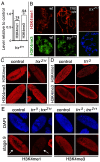
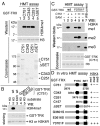
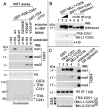

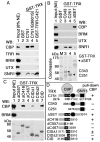

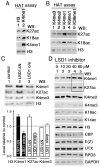
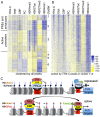
Similar articles
-
CBP-mediated acetylation of histone H3 lysine 27 antagonizes Drosophila Polycomb silencing.Development. 2009 Sep;136(18):3131-41. doi: 10.1242/dev.037127. Development. 2009. PMID: 19700617 Free PMC article.
-
Polycomb inhibits histone acetylation by CBP by binding directly to its catalytic domain.Proc Natl Acad Sci U S A. 2016 Feb 9;113(6):E744-53. doi: 10.1073/pnas.1515465113. Epub 2016 Jan 22. Proc Natl Acad Sci U S A. 2016. PMID: 26802126 Free PMC article.
-
Histone demethylase UTX and chromatin remodeler BRM bind directly to CBP and modulate acetylation of histone H3 lysine 27.Mol Cell Biol. 2012 Jun;32(12):2323-34. doi: 10.1128/MCB.06392-11. Epub 2012 Apr 9. Mol Cell Biol. 2012. PMID: 22493065 Free PMC article.
-
[Control of the gene activity by polycomb and trithorax group proteins in Drosophila].Genetika. 2017 Feb;53(2):133-54. Genetika. 2017. PMID: 29372960 Review. Russian.
-
Genome regulation by polycomb and trithorax proteins.Cell. 2007 Feb 23;128(4):735-45. doi: 10.1016/j.cell.2007.02.009. Cell. 2007. PMID: 17320510 Review.
Cited by
-
Chromatin Modifiers in Transcriptional Regulation: New Findings and Prospects.Acta Naturae. 2021 Jan-Mar;13(1):16-30. doi: 10.32607/actanaturae.11101. Acta Naturae. 2021. PMID: 33959384 Free PMC article.
-
Epigenetic Regulation of Neuroinflammation in Alzheimer's Disease.Cells. 2023 Dec 29;13(1):79. doi: 10.3390/cells13010079. Cells. 2023. PMID: 38201283 Free PMC article. Review.
-
Separate Polycomb Response Elements control chromatin state and activation of the vestigial gene.PLoS Genet. 2019 Aug 19;15(8):e1007877. doi: 10.1371/journal.pgen.1007877. eCollection 2019 Aug. PLoS Genet. 2019. PMID: 31425502 Free PMC article.
-
Epigenetic regulation of female puberty.Front Neuroendocrinol. 2015 Jan;36:90-107. doi: 10.1016/j.yfrne.2014.08.003. Epub 2014 Aug 27. Front Neuroendocrinol. 2015. PMID: 25171849 Free PMC article. Review.
-
Polycomb and Trithorax Group Proteins: The Long Road from Mutations in Drosophila to Use in Medicine.Acta Naturae. 2020 Oct-Dec;12(4):66-85. doi: 10.32607/actanaturae.11090. Acta Naturae. 2020. PMID: 33456979 Free PMC article.
References
-
- Arnold C. D., Gerlach D., Stelzer C., Boryń L. M., Rath M., Stark A. (2013). Genome-wide quantitative enhancer activity maps identified by STARR-seq. Science 339, 1074–1077 - PubMed
-
- Bonn S., Zinzen R. P., Girardot C., Gustafson E. H., Perez-Gonzalez A., Delhomme N., Ghavi-Helm Y., Wilczyński B., Riddell A., Furlong E. E. (2012). Tissue-specific analysis of chromatin state identifies temporal signatures of enhancer activity during embryonic development. Nat. Genet. 44, 148–156 - PubMed
Publication types
MeSH terms
Substances
Grants and funding
LinkOut - more resources
Full Text Sources
Other Literature Sources
Molecular Biology Databases
Research Materials

